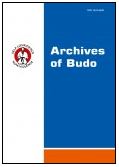2017, Volume 13
Effectiveness of avoiding collision with an object in motion – virtual reality technology in diagnostic and training from perspective of prophylactic of body injuries
Robert Michnik1, Piotr Wodarski1, Andrzej Bieniek1, Jacek Jurkojć1, Dariusz Mosler2, Roman Maciej Kalina3
1Faculty of Biomedical Engineering, Department of Biomechatronics, Silesian University of Technology, Zabrze, Poland
2Institute Physical Education, Tourism and Physiotherapy, Jan Dlugosz University of Czestochowa, Czestochowa, Poland
3Department of Combat Sports, Gdansk University of Physical Education and Sports, Gdansk, Poland
Author for correspondence: Robert Michnik; Faculty of Biomedical Engineering, Department of Biomechatronics, Silesian University of Technology, Zabrze, Poland; email: robert.michnik[at]polsl.pl
Full text
Abstract
Background and Aim: People older than 60 years, with dysfunctions of musculoskeletal or motor system, impaired vision or hearing etc. are in a group of higher risk of collisions with objects in motion, which suddenly are heading towards their body (cyclists, runners, thrown an object, intentional punch or kick etc.). This study aims to verify compensation possibilities of this category of threats by a person who is cumulating a few factors of higher risk of collision with an object in motion heading toward his head, but on the other hand, having a longstanding adaptation for this kind of threats.
Material and Methods: Two men have been subjected to the study: a 68-years-old and 27-years-old. Measurements have been performed with the use of MVN Biomech System (XSENS). Application projects a ball with a diameter of 12 cm, which fly with constant velocity (three trials; 10-, 6- and 3 m/s) alongside axis perpendicular to a frontal plane on the height the head and legs of the participant in an initial moment.
Results: Men B avoided collision head with an object in motion three times. Man A avoided it only with a velocity of 3 m/s. Mean time of reaction of men A was 0.407 ±0.27s and was 35% longer than man B (0.263 ±0.05s). Man A performed body rotation faster (0.870 ±0.636s) than B (1.133 ±0.054s); moves his centre of mass more efficiently in the frontal plane (5.953 ±0.034deg) and sagittal plane (6.185 ±0.959deg) than men B (9.825 ±2.909deg) and (13.001 ±0.451deg). Man A managed to avoid collision with a ball with a diameter of 12 cm for the left knee at the highest velocity (10 m/s). Man B did not avoid collision nor for the left or right knee in the same circumstances. Kinematic trajectory for following velocities registered for 27 years old men differs significantly.
Conclusion: Positive adaptation effects for 68 years old men (most of the analysed time graphs of kinematics quantities were similar) is an empiric proof, that some category of “life sports” guarantee an optimal level of motor safety to a late elderly. Furthermore, adequately adapted virtual reality technology could be an effective and attractive tool for enhancing training of avoiding collisions on small space (in the apartment, garage etc.) despite weather or other circumstances.
Key words: health-related training, life sports, motor safety, prophylactic and therapeutic agonology, martial arts, safe fall




